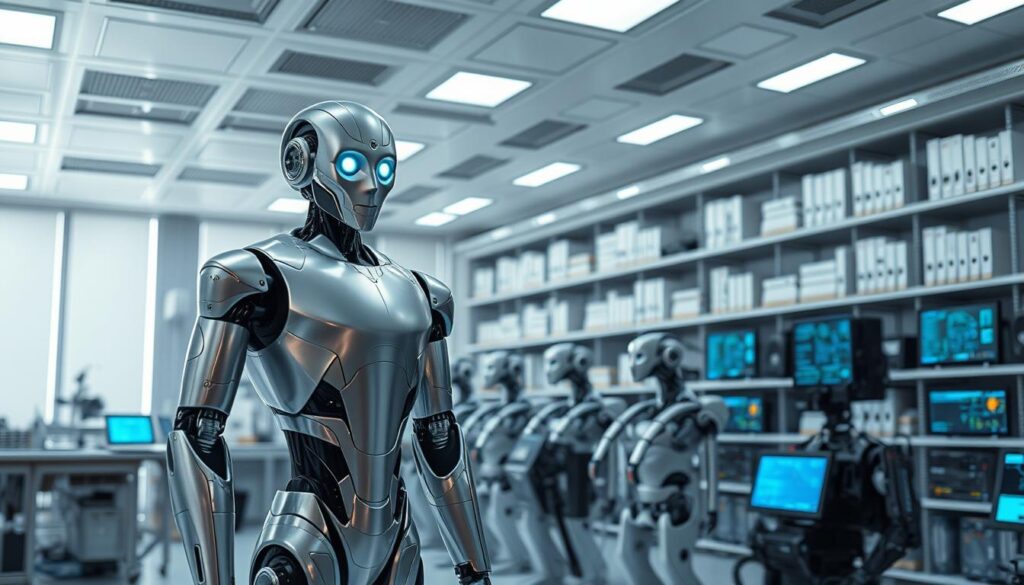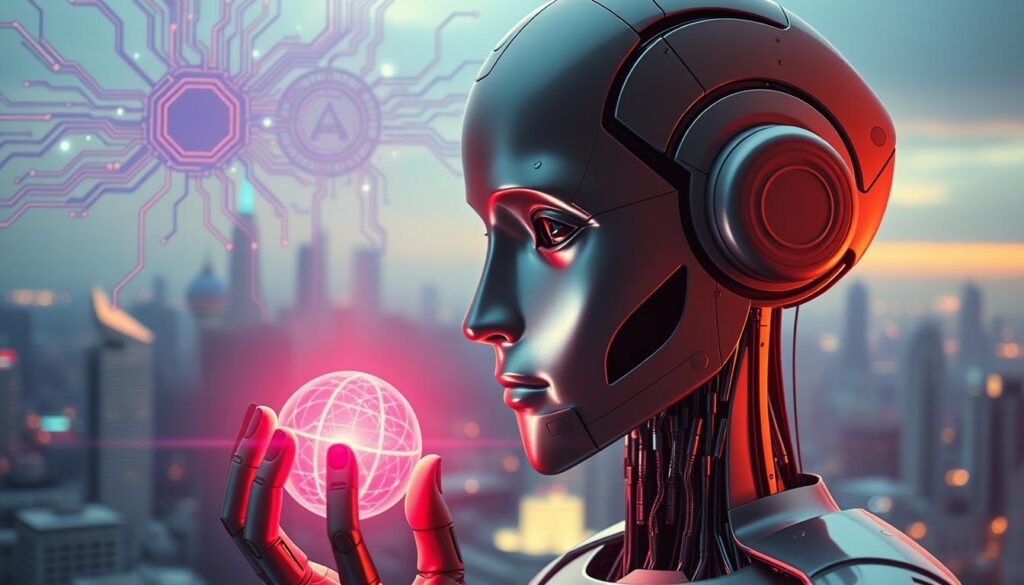I’m excited to dive into the world of artificial intelligence and its effects on our lives. As we use AI more, we open up new chances for growth and creativity.
AI is changing how we live and work in many fields. It makes customer service better and makes complex tasks easier. Artificial intelligence is making a big difference in our world.
Key Takeaways
- Understanding the basics of AI and its applications
- Exploring the benefits of AI in various industries
- Recognizing the potential challenges and limitations of AI
- Discovering the future prospects of AI and its impact on society
- Learning how to harness the power of AI for innovation
The Evolution of Artificial Intelligence
Exploring the history of artificial intelligence reveals a captivating journey. It spans centuries, from early ideas to today’s applications. This journey is driven by human curiosity and the dream of creating intelligent machines.
From Science Fiction to Reality
The idea of AI started in science fiction. Authors like Isaac Asimov and Arthur C. Clarke imagined intelligent machines. Their stories predicted AI’s potential and raised important ethical questions.
Early AI Concepts in Literature and Film
Literature and film have shaped how we see AI. Classics like 2001: A Space Odyssey and I, Robot introduced us to thinking machines. These stories inspired scientists and engineers to make AI a reality.
The Turing Test and Early AI Theory
In 1950, Alan Turing proposed the Turing Test. It measures a machine’s ability to think like a human. This idea helped start AI research, focusing on machines that can think like us.
Key Milestones in AI Development
AI’s growth includes major milestones like machine learning and deep learning. These advancements let machines learn from data and make smart decisions.
The AI Winters and Resurgence
AI has faced funding cuts and lost interest, known as “AI winters.” But, it always comes back. This is thanks to better computers and more data.
Breakthrough Moments That Changed Everything
Recently, AI has made huge strides. It beat human champions in games like Go and helped create self-driving cars. These achievements show AI’s power to change industries and our lives.
Understanding Artificial Intelligence
Artificial intelligence has become a big part of our lives. It’s important to know what AI really is as we use it more.
Defining AI in Modern Context
Artificial intelligence means making computers do things that humans do, like seeing, talking, and making choices.
What Makes a System “Intelligent”
A system is smart if it can learn from new info, use what it knows, and reach its goals.
My Perspective on AI’s Core Principles
I think AI’s main points are about handling lots of data, spotting patterns, and making smart choices based on that data.
Types of AI: Narrow vs. General Intelligence
AI is split into narrow (weak) AI and general (strong) AI.
Weak AI: Systems We Use Today
Weak AI does one thing well, like recognizing faces, translating languages, or playing games.
Strong AI: The Path to Human-Like Intelligence
Strong AI wants to make machines as smart as humans. They should understand, learn, and do many things.
| Type of AI | Description | Examples |
|---|---|---|
| Narrow (Weak) AI | Designed to perform a specific task | Facial recognition, language translation |
| General (Strong) AI | Possesses human-like intelligence | Hypothetical AI that can understand and learn like humans |
The Building Blocks of AI
Artificial Intelligence (AI) is built on learning and adapting. This is mainly done through machine learning and neural networks. Knowing these basics is key as AI changes many fields.
Machine Learning Fundamentals
Machine learning is a part of AI that lets systems get better at tasks on their own. It doesn’t need to be told how to do it. There are different ways to do machine learning.
Supervised vs. Unsupervised Learning
Supervised learning uses labeled data to train a model. Unsupervised learning works with data without labels. It finds patterns by itself.
Reinforcement Learning Models
Reinforcement learning lets models learn by interacting with their environment. They get feedback in the form of rewards or penalties.
Deep Learning and Neural Networks
Deep learning is a part of machine learning that looks at how the human brain works. It uses neural networks to understand data.
How Neural Networks Mimic the Human Brain
Neural networks have layers of nodes or “neurons” that process information. They work together to analyze data.
“Deep learning is a key technology behind the recent advances in AI, enabling machines to perform complex tasks like image and speech recognition.”
Training Models: Data Requirements and Challenges
To train these models, lots of data and powerful computers are needed. But, there are also big challenges like overfitting and poor data quality.
Natural Language Processing: How Machines Understand Us
NLP is a part of artificial intelligence that lets computers understand and use human language. This has changed how we talk to machines, making it feel more natural.
The Science Behind NLP
NLP has grown a lot, moving from old rule-based systems to new neural network methods.
From Rule-Based to Neural Approaches
At first, NLP used rules that couldn’t handle the complexity of human speech. Now, with neural networks, machines can learn from big data and understand language better.
Large Language Models and Their Capabilities
Large language models, built with neural networks, have done very well in NLP. They can write text, answer questions, and even talk to people. This shows their wide range of uses.
Applications in Daily Life
NLP affects our daily lives in many ways, from virtual assistants to translation tools.
Virtual Assistants and Chatbots
Virtual assistants like Siri and Alexa use NLP to get what you say and respond. Chatbots also use NLP for text chats, helping with customer service.
Translation and Content Creation Tools
Translation tools powered by NLP make talking across languages easier. Content creation tools use NLP to help with writing and editing, making work faster.
As NLP keeps getting better, we’ll see even more ways it changes how we use technology.
Computer Vision: AI That Sees the World
Computer vision is a part of AI that changes how machines see the world. It lets machines understand and analyze visual data. This way, they can do things that humans do with their eyes.
How Computer Vision Works
At its heart, computer vision uses machine learning to understand images. These algorithms learn from huge sets of pictures. This helps them spot patterns and make smart guesses.
Image Recognition and Classification
One big use of computer vision is recognizing and sorting images. Machines learn to spot objects in pictures and sort them. Deep learning has made these systems much better at recognizing images.
Object Detection and Tracking
Computer vision also helps find and track objects in images. It’s not just about recognizing objects. It’s about finding where they are and following them over time. This is key for things like watching over areas and for self-driving cars.
Real-world Applications
Computer vision has many uses in real life. It’s great at looking at and understanding pictures. This makes it very useful in lots of areas.
Medical Imaging and Diagnostics
In healthcare, computer vision helps look at medical pictures like X-rays and MRIs. It helps doctors find diseases early and make more accurate diagnoses.
Autonomous Vehicles and Surveillance
In cars, computer vision is key for self-driving cars. It lets them see and react to their surroundings. It also helps in surveillance by watching and analyzing video footage. This makes security better.
Robotics and AI: Creating Intelligent Machines
Artificial intelligence is changing how machines work with the world. AI is making robots smarter, so they can do complex tasks well. This is a big step forward.
The Integration of AI in Physical Systems
AI and robotics are coming together to make smart machines. These machines can think, learn, and act. They are being used in many areas, like factories and homes.
Industrial Robotics and Automation
In factories, AI helps robots do jobs that need human smarts. AI-powered robots get better with time. They make work more efficient and save money.
Consumer and Service Robots
AI is also making robots for everyday tasks. These robots help with cleaning, health care, and customer service. They are easy to use and can adjust to different places and situations.
Challenges in Robotic AI
Even with progress, there are still big challenges. One major one is getting robots to work well with the physical world.
Physical World Interaction Problems
Robots must see, understand, and act like humans. This means we need big improvements in vision, language, and learning.
My Observations on Human-Robot Collaboration
I think the biggest chance is in robots working with humans. This could make systems more efficient and effective.

The future of robotics and AI is bright. It will bring new chances in many fields. As we explore more, we’ll see even smarter machines.
Data Science and Artificial Intelligence
Exploring AI, it’s clear data science is key. The bond between data science and AI is symbiotic. They work together to innovate and solve big problems.
The Symbiotic Relationship
Data science is vital for AI growth. It gives AI the data it needs to learn. Machine learning, a part of AI, uses data to spot patterns and predict outcomes.
How Data Fuels AI Development
Data quality and amount affect AI’s performance. Big data lets AI learn from many scenarios, making it more accurate. Preparing data for AI is crucial.
Big Data Processing Techniques
Big data processing deals with huge data sets. Tools like Hadoop and Spark help process this data. This lets companies find valuable insights for AI and business decisions.
From Data to Insights
Data science aims to turn data into useful insights. It uses various methods to find meaningful patterns. Predictive analytics is where data science and AI meet, helping predict trends and make smart choices.
Predictive Analytics and Decision Support
Predictive analytics uses past data to forecast the future. It helps businesses understand customers, markets, and operations. This knowledge aids in making strategic decisions.
Data Visualization and Interpretation
Data visualization makes complex data easy to understand. It helps organizations make better decisions. Tools like Tableau and Power BI are used for this.
In summary, combining data science and AI is changing industries. As data grows, so will the role of data science in AI.
The Ethics of AI Development
As we explore AI, we face big ethical questions. AI is changing our lives in many ways. It’s important to tackle these issues head-on.
Bias and Fairness Concerns
AI can have biases, which is a big problem. These biases come from:
- Data Quality Issues: Bad data can lead to unfair results.
- Algorithmic Design: How algorithms are made can also cause bias.
To fix these problems, we need to:
- Diverse Data Sets: Use data that shows all kinds of people.
- Regular Audits: Check AI for bias often.
Sources of AI Bias
Knowing where AI bias comes from is key. It often comes from old data that shows unfair views.
Strategies for Creating Fair AI Systems
To make AI fair, we need to do several things. This includes using diverse data, making algorithms clear, and watching AI closely.
Privacy and Security Implications
AI also raises big privacy and security worries. It deals with a lot of personal data, which can be risky.
Data Protection Challenges
Keeping data safe from hackers is hard. We must have strong ways to protect it.
Balancing Innovation with Ethical Constraints
It’s hard to keep up with new AI while following ethics. We need to understand AI’s ethics and innovate responsibly.

In conclusion, we must deal with AI’s ethics to make sure it helps everyone. By fighting bias, keeping data safe, and balancing new ideas with ethics, we can create a better AI future.
The Future of Work in an AI-Driven World
In an AI-driven world, work is changing a lot. This change affects jobs and industries. It’s important to know both the challenges and opportunities AI brings.
Jobs at Risk of Automation
AI can automate many tasks, which changes the workforce. Jobs that are repetitive or routine are more likely to be automated.
Industries Facing Disruption
- Manufacturing: Robotics and machine learning are making manufacturing more automated.
- Customer Service: Chatbots and virtual assistants are changing customer service, handling inquiries and support requests.
- Transportation: Self-driving vehicles could change the transportation sector, affecting jobs related to driving.
Timeline Predictions for Job Displacement
Experts say the next decade will see a lot of job changes due to AI and automation. A report by the McKinsey Global Institute says up to 800 million jobs could be lost worldwide by 2030.
New Opportunities Created by AI
AI also brings new chances in the job market. New technologies need new skills, creating new roles and industries.
Emerging Roles and Skills
New roles include AI and machine learning specialists, data scientists, and cybersecurity experts. There’s also a need for skills in critical thinking, creativity, and solving complex problems.
How I’m Preparing for the AI-Transformed Workplace
I’m learning skills that work well with AI, like data analysis and interpretation. I also keep up with the latest tech. I think learning and being adaptable are key to doing well in an AI world.
Conclusion: Embracing the AI Revolution
Artificial intelligence is changing our world. It has evolved a lot and is now used in many areas. This includes natural language processing, computer vision, and robotics.
AI is making big changes in different industries and our daily lives. The future of AI looks very promising. It could bring even more advancements in data science and machine learning.
But, we need to think about the ethics of AI. We must make sure AI systems are fair, open, and safe. Embracing AI is key to unlocking its full potential.
By understanding and using AI, we can make a better future for everyone. The AI future is not just about new tech. It’s about how we shape it.



